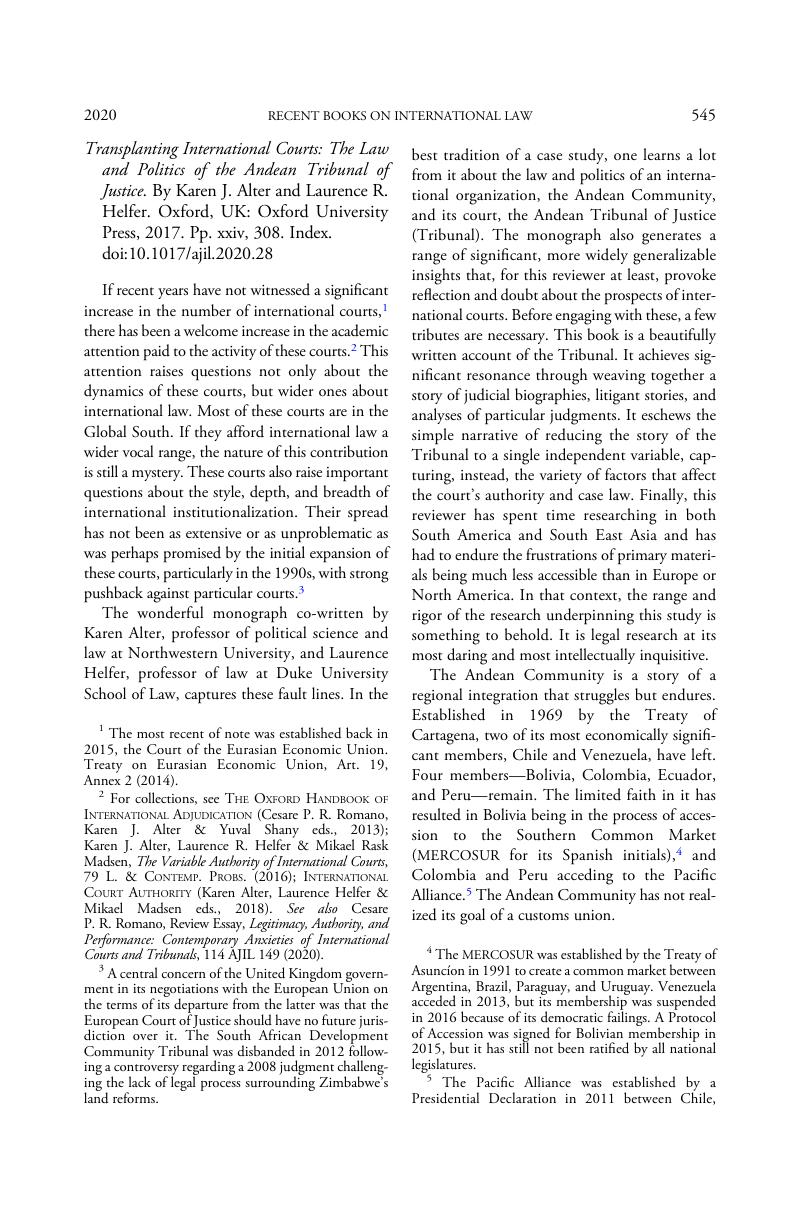No CrossRef data available.
Article contents
Transplanting International Courts: The Law and Politics of the Andean Tribunal of Justice. By Karen J. Alter and Laurence R. Helfer. Oxford, UK: Oxford University Press, 2017. Pp. xxiv, 308. Index.
Review products
Published online by Cambridge University Press: 17 July 2020
Abstract

- Type
- Book Reviews
- Information
- Copyright
- Copyright © 2020 by The American Society of International Law
References
1 The most recent of note was established back in 2015, the Court of the Eurasian Economic Union. Treaty on Eurasian Economic Union, Art. 19, Annex 2 (2014).
2 For collections, see The Oxford Handbook of International Adjudication (Cesare P. R. Romano, Karen J. Alter & Yuval Shany eds., 2013); Alter, Karen J., Helfer, Laurence R. & Madsen, Mikael Rask, The Variable Authority of International Courts, 79 L. & Contemp. Probs. (2016)Google Scholar; International Court Authority (Karen Alter, Laurence Helfer & Mikael Madsen eds., 2018). See also Romano, Cesare P. R., Essay, Review, Legitimacy, Authority, and Performance: Contemporary Anxieties of International Courts and Tribunals, 114 AJIL 149 (2020)CrossRefGoogle Scholar.
3 A central concern of the United Kingdom government in its negotiations with the European Union on the terms of its departure from the latter was that the European Court of Justice should have no future jurisdiction over it. The South African Development Community Tribunal was disbanded in 2012 following a controversy regarding a 2008 judgment challenging the lack of legal process surrounding Zimbabwe's land reforms.
4 The MERCOSUR was established by the Treaty of Asuncíon in 1991 to create a common market between Argentina, Brazil, Paraguay, and Uruguay. Venezuela acceded in 2013, but its membership was suspended in 2016 because of its democratic failings. A Protocol of Accession was signed for Bolivian membership in 2015, but it has still not been ratified by all national legislatures.
5 The Pacific Alliance was established by a Presidential Declaration in 2011 between Chile, Colombia, Mexico, and Peru, which was formalized by a Framework Agreement agreed at Antofagasta, Chile in 2012. A central objective set out in Article 2(1)(a) of the Framework Agreement is a “deep area of integration” in which there is progressive liberalization of the movement of goods, persons, services, and capital.
6 Tribunal de Justicia de la Comunidad Andina, Informe de Labores Gestión 2019, 5 (2020).
7 Helfer, Laurence R., Alter, Karen J. & Guerzovich, M. Florencia, Islands of Effective International Adjudication: Constructing an Intellectual Property Rule of Law in the Andean Community, 103 AJIL 1, 9–10 (2009)CrossRefGoogle Scholar.
8 Agreement of Lusaka Establishing an African Regional Intellectual Property Office, Art. III (1977).
9 Levi-Faur, David, The Global Diffusion of Regulatory Capitalism, 598 Annals Am. Acad. Pol. & Soc. Sci. 12 (2005)Google Scholar.
10 Chalmers, Damian & Chaves, Mariana, The Reference Points of EU Judicial Politics, 19 J. Eur. Pub. Pol'y 25 (2012)Google Scholar.




